The Rio de Janeiro State Team Championship – An 83-year-old tradition
By Albert Silver
In spite of many outsider expectations regarding chess in Brazil, and notably my home, Rio de Janeiro, the game has a long and deep history here, starting with the very first club, co-founded among others, by the legendary writer Machado de Assis. The noted author, listed by noted critic Harold Bloom as one of the greatest authors of all time, also took part in the very first chess tournament held in Brazil in 1880.
In 1928, the first Rio de Janeiro State Team Championships were held, won by Fluminense Football Club. In case you think I mistyped, it is important to understand that the world famous football clubs are home to more than just football, and are often home to a wide variety of sports, including chess. Other famed football clubs whose chess teams took the State championship include Flamengo as well as Botafogo and Vasco. My club, the Tijuca Tênis Clube, won its first State title over 70 years ago in 1941, and no fewer than 16 times since then, including this year in 2011, making it the most successful club in the event's history.
Personally, I look forward to the wonderful tournament, in a chance to defend my club's colors, as well as meet up with many players, competing or not, whom I sometimes only get to see at this great 'family' gathering. It wasn't without a great deal of surprise that I learned from an American GM that the US had no such event in any of the states, which frankly just baffled me. Could that be true?
In any case, allow me to share this fun and intense event with you via pictures I took throughout the competition.

This year's event was held in the Tijuca Tênis Clube, also encroaching on the largest
urban forest in the world, the Tijuca Forest. In spite of the wet weather, one can see
the forest-covered mountains in the backdrop.

Near the tennis courts, once can see the vegetation and tree types that surround it

Naturally, what kind of a sports club would it be without a swimming pool. Especially in Rio.

The event kicked off with Reynaldo Velloso, the chess club president, gifting seven-time
Brazilian Champion,
Giovanni Vescovi, with the club's t-shirt.

Vescovi was present to also promote the ADX, Association for Chess Development,
seeking to promote chess instruction throughout the country.

In the first day of the competition, he accepted challengers from all comers to a blitz
game, a unique chance for many to play with the champion.When asked what he
thought of the competition, he said, "It is certainly hard-fought!"

Obviously the younger generation were present
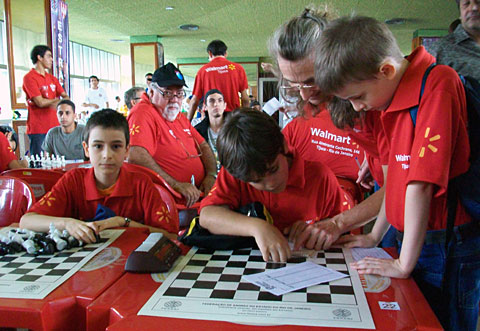
All well-taken care of with instructions and pre-competition meetings

The young line-up by the Jacarépagua Tênis Clube
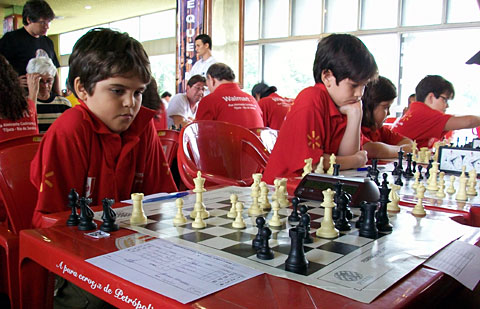
GianLuca, who was top board of the 'C' team, scored a perfect 6.0/6 and will represent
Brazil in the next World Youth Championships.
Note that there
are three rating categories used in Rio, 'C' which is for all ratings up to 1599, 'B' for
players rated 1600-1899, and 'A' for players rated 1900 and above.
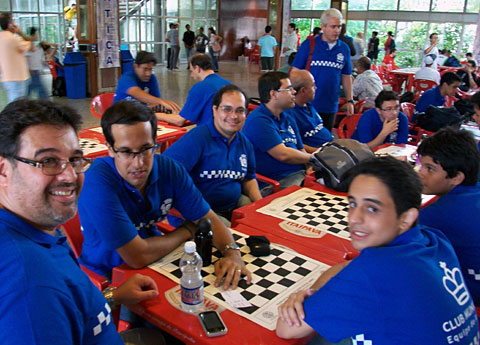
As is often the case, many of the teams came with signature shirts to represent their
club and players. Here are the players of the Clube Municipal.

Even clubs from smaller towns such as the seaside resort Cabo Frio showed their unity
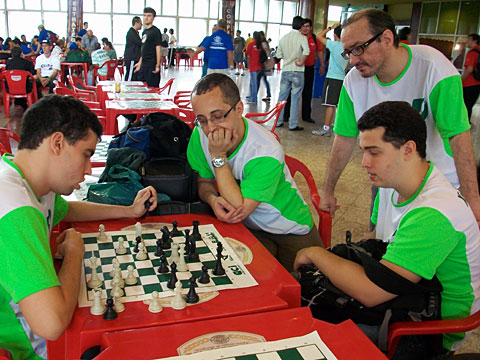
Some players in the green and white shirts from IBC, the Iguaçu Basketball Club,
analyze a game with the help of their strongest team member, FM Hilton Rios, standing behind.
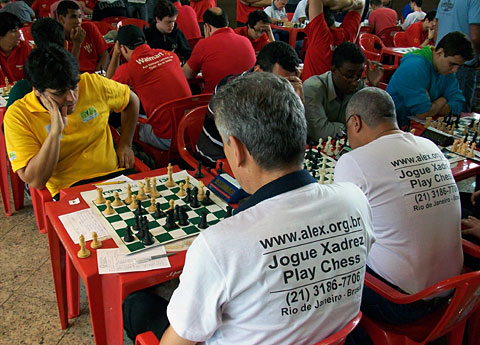
Some teams astutely used their shirts as marketing tools, such as the ALEX.

The Tijuca Tênis obtained sponsorship from Walmart, whose logo was emblazoned
on all the shirts. The top team brought in a singularly strong line-up with captain
FM Ricardo Teixeira (missing out on playing for the first time in 37 years),
GM Krikor
Mekhitarian, IM Diego Di Berardino, IM German Della Morte, and GM José Cubas. Prior
to each round, they would shake hands of the members of other teams and wish them luck.
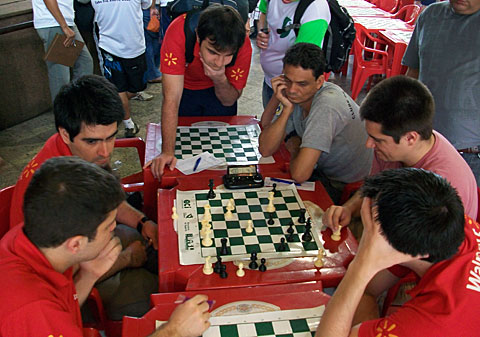
For some, these hired guns were viewed as an unfair means to secure a title, which
they duly won, but for
many it was a rare chance to play a titled player and benefit
from their views and analysis.

And for a select few, it was an even rarer chance for a prized scalp. Here the Norwegian
WIM
Katrine Tjolsen, 18-years-old, residing in Rio de Janeiro, held GM Mekhitarian
to a draw.
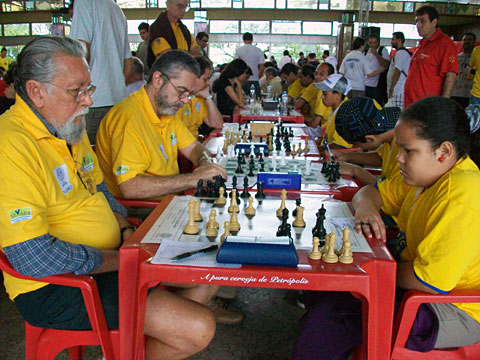
The competition was not only reserved for titled players, and included competitors
of all levels.

David lost to Goliath, but you can be sure the roles will be reversed in no time!

Team events mean what happens on your neighbor's board can require more attention
than idle curiosity. In a funny crisscross, both players of board one observe board two,
while the board two
player checks their time.

This picture was taken after one of the most unbelievable bluffs I ever saw in an 'A'
category game.
The jocular look of innocence into the void is completely appropriate.
The story requires a board. It also bears reminding that both players involved are rated over 1900.

[Event "?"]
[Site "?"]
[Date "2011.10.16"]
[Round "?"]
[White "The giant bluff"]
[Black "?"]
[Result "1-0"]
[SetUp "1"]
[FEN "3R1Q2/p1r2p1p/6p1/7k/8/5qP1/P4P1P/6K1 w - - 0 1"]
[PlyCount "3"]
[EventDate "2011.??.??"]
{With minutes left on the clock and seeing no way to save against mate on the
back rank, White actually played...} 1. Qa3 $5 {and began staring at the c1
square as if this move were designed to prevent Rc1 mate. As if hypnotized,
Black did not take the hanging queen, and instead played} Rc2 $4 {and after} 2.
Qxf3+ $1 {turned beet red and resigned.} 1-0
In spite of this chess moment straight out of a Monty Python film, which helped secure the team's only drawn match, it did not prevent them from coming dead last in the competition. Better luck next time guys!

Here one can see the many teams during the grueling two-day competition in which
six FIDE rated games are played, three a day!

Chess also has the ability to bridge the gap between gender and race like
few others

On a personal note, the event went quite well for me (left playing black), and I finished
the tournament
with a solid 2414 performance.
This was my shortest win, a 19-move victory in a Classical King's Indian:

[Event "Rio de Janeiro State Team Championship"]
[Site "?"]
[Date "2011.10.16"]
[Round "6"]
[White "C.M., Jorge Luis"]
[Black "Silver, Albert"]
[Result "0-1"]
[ECO "E99"]
[WhiteElo "2098"]
[BlackElo "2092"]
[Annotator "Albert Silver"]
[PlyCount "38"]
[EventDate "2011.??.??"]
[SourceDate "2011.10.17"]
1. Nf3 Nf6 2. d4 g6 3. c4 Bg7 4. Nc3 O-O 5. e4 d6 6. Be2 e5 7. O-O Nc6 8. d5
Ne7 9. Ne1 Nd7 10. f3 f5 11. Be3 Nf6 $6 {A serious imprecision that could have
cost me, however my opponent wasn't much better versed in theory than I was.
Thankfully.} (11... f4 12. Bf2 g5 {is the obvious way to go.}) 12. c5 f4 13.
Bf2 g5 14. Rc1 Ng6 15. Qa4 $6 {My opponent tried to be a little over-creative
(or positional, it is hard to know), but this loses a lot of time.} (15. cxd6
$1 {is the best continuation and would give White a large advantage.}) 15... g4
16. Qa3 {Consistent, but leads to a swift punishment.} g3 $1 17. hxg3 Nh5 18.
gxf4 exf4 $6 (18... Ngxf4 $1 {was stronger and winning.}) 19. cxd6 $2 ({The
engines say White could save with} 19. Nc2 $1 {but the lines are long and
complex, and not something easily found at the board.}) 19... Ng3 $1 {Although
I played this fairly quickly, my opponent clearly never saw it coming, and
thought for a half hour, trying to find a saving grace. Failing to find one he
extended his hand. Aside from Qh4-h1 mate, Black is threatening to pick up a
piece with Bxc3, or a rook if Rxc3 Nxe2+.} 0-1

The team from Cabo Frio, a seaside resort municipality with a population of 160,000,
was
proud to take
the 'B' title, their first in their club's history.
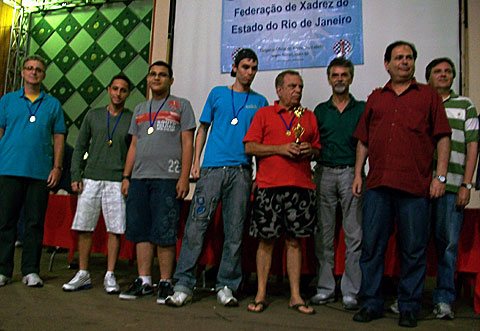
No less proud were the members of the AXXM, the Checkmate Chess Association,
whose club has only been in existence for three years, and who took the 'C' title.

The event could not have run as smoothly as it did without the help of the arbiters
Marius van Riemsdijk and Christian van Riemsdijk.

The 'family' picture of all the Tijuca Tênis players
Pictures by Albert Silver
Copyright
ChessBase




















































